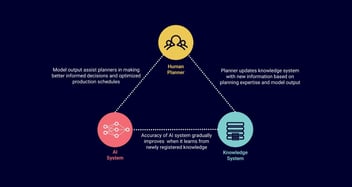Production Planning & Scheduling
Digitize Your Way of Working
Four enablers for accelerated production planning & scheduling
Manufacturing companies that intend to lead the way in digitizing their planning and scheduling efforts and want to make a lasting impact with AI have to overcome some organizational and technical challenges. Happily, technology is rapidly evolving, and new platforms and tools are coming on the market that provide the necessary technical building blocks to address these challenges and make it possible to embed analytics in every aspect of the day-to-day or even minute-to-minute decision making processes.
In a series of blog posts we show what it takes to successfully implement a digitized production planning and scheduling process at scale. We identified four key enablers that will help planners in making better, faster, and smarter decisions. Previously, we discussed the value of building a digitial twin from a planners perspective and why it's worth digitizing all planners knowledge. In this post we look at how to digitize your way of working.

Four enablers for accelerated production planning & scheduling - step 3
Software on its own will not drive a digital revolution
Companies that want to foster innovation should equip their workforce with the right digital tools. Having to head to the office and boot up a desktop application to get the latest view of your production schedule should be a thing of the past. But software on its own will not drive a digital revolution. To enable collaboration, communication, faster problem solving, and higher levels of trust in data and algorithms, manufacturers must embrace new mindsets and behaviors. Strong change leadership skills are therefore indispensable to establish a digital-first enterprise and a data-driven cultural mindset.
What makes a good toolkit?
Using the right tools on a day-to-day basis will accelerate these new digital working behaviors, and boost both operational efficiency and customer agility. A modern planning toolkit should give planners a centralized, realtime view of production progress, and highlight any gaps between the plan and reality. It should allow integration with other tier-1 software applications such as your EPR or MES system and provide smart notifications to enable rapid responses in changing operational and commercial conditions.
Automation will free up time for review and in-depth analysis.
To support decision making in the field, a good toolset should also come with simulation capabilities for analyzing the impact of last-minute changes or temporary deviations in the production schedule. Automation itself should lead to less trial-and-error analysis and less need for manual data capture. This in turn will free up time for review and in-depth analysis.
Digital tools should look familiar for planners & schedulers
A new generation of digital natives are joining the workforces. This technological savvy generation has been raised in a digitally endowed world. They can easily adapt to change and are used to work with digital tools and new technologies.
However, we should not forget that some planners are still using pin boards, index cards and post-it notes. When Excel came along, most people adopted spreadsheets to speed up their work and eliminate repetitive tasks as far as possible. Today, within most organizations, the entire planning process is operated via a series of Excel workbooks, managed and understood by some lone individuals. Those individuals are not always open to change, beause it alerts their familiar way of working.
Say goodbye to Excel.
Therefore, it is important to provide planners with concepts and tools they are already familiar with, such as Gantt charts or digital sticky notes. This will enhance initial user adoption and boost employee engagement. Eventually, all planners will start using digital tools when they can perform tasks more efficiently.
Want to know more?Download our whitepaper on how to accelerate with production planning & scheduling.


